What is an email address of an ideal customer worth to you?
It’s not a stretch to presume the answer is: a lot. According to a Litmus survey, the average return on investment of email marketing is 38:1. Your email list is precious, and email addresses have become a valuable currency.
Gating your content is one of the simplest ways to fuel your list building. So the question you may have is: why wouldn’t you put most or all of your content behind a gate and turn it into a list-building machine?
That’s what I’m answering in this guide. I’m diving into gated and ungated content pros and cons – loaded with examples, use cases, and questions that will help you choose the best option for your company.
Gated content vs ungated content: overview
Gated content is a piece of content only accessible after the visitor has filled out a form.
Brutally honest take: if you decide to gate your content, it better be damn good.
The ultimate goal of gating content is lead generation—the access to your target customer’s email inbox. This is a long term inbound strategy. Don’t expect to build a massive list overnight.
Many companies prefer a gated content strategy because it decreases reliance on sending cold emails and other outbound tactics, which can be quite taxing. Contacts who opt-in from gated sources might eventually become paying customers down the road, but they’re not going to open their wallets after reading one eBook.
Here are some examples of gated content:
- Report with original research
- Ebook
- Whitepaper
- Live demo
- Webinar
- Newsletter content
Nextiva’s recent example of gated content is our 2020 State of Business Communication Report:
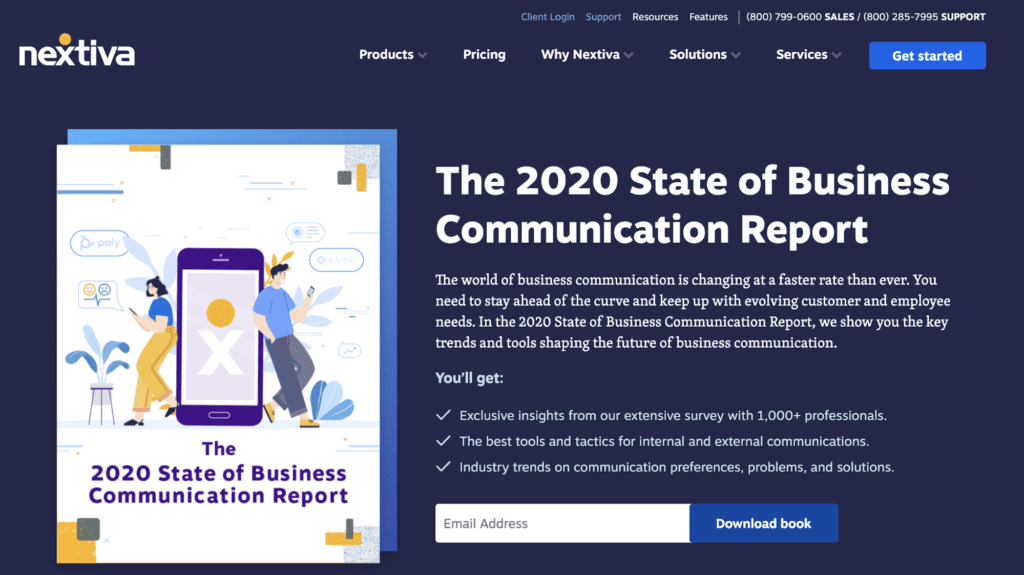
Ungated content is any piece of content freely available on the internet. Anything you can access without filling out a form or making a payment is ungated content. You can see, view, or interact with it whenever you wish.
Unlike with gated content, ungated content offers educational value and asks nothing in return. This helps you build organic awareness and encourage your audience to keep consuming your content and share it with their peers.
These are a few examples of ungated content:
- Blog post
- Video (on the website, on YouTube, etc.)
- Podcast
- Infographic
- Ungated PDF (for example, a link within a blog post to a one-page checklist)
For example, Moz offers all of their Whiteboard Friday videos available for free on their website without a form (and some of them are YouTube, too):
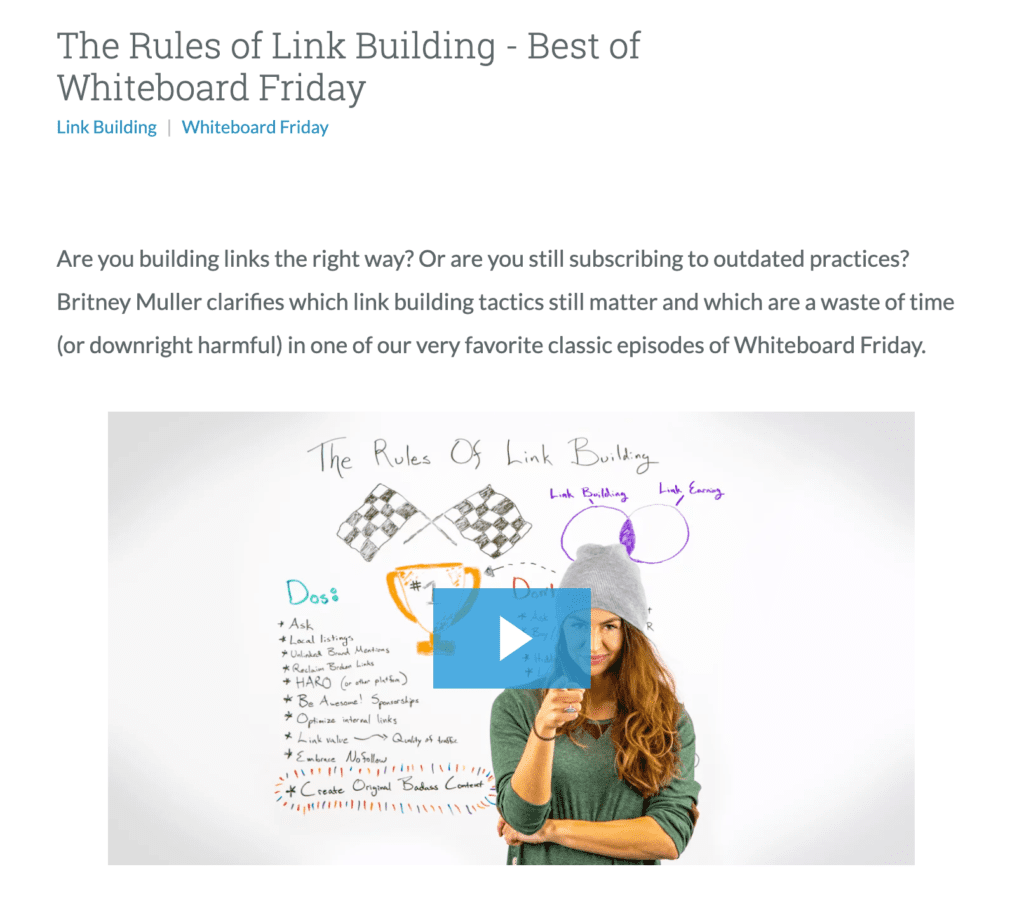
Here’s a side-by-side comparison of typical types of gated and ungated content:
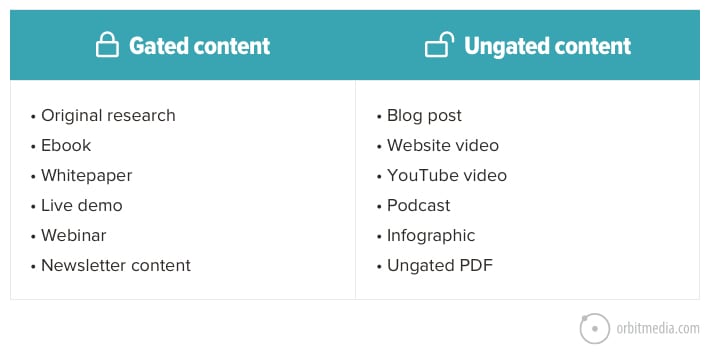
Bonus! Ungated content can be anything you decide to publish without a “gate.” If you want to make your ebook, original research, or webinar available without a required form, you absolutely can.
In other words, you can make any type of content ungated content. Even though Orbit gathers valuable data through their blogging survey every year, they don’t keep it behind a gate. It’s simply published as a blog post:
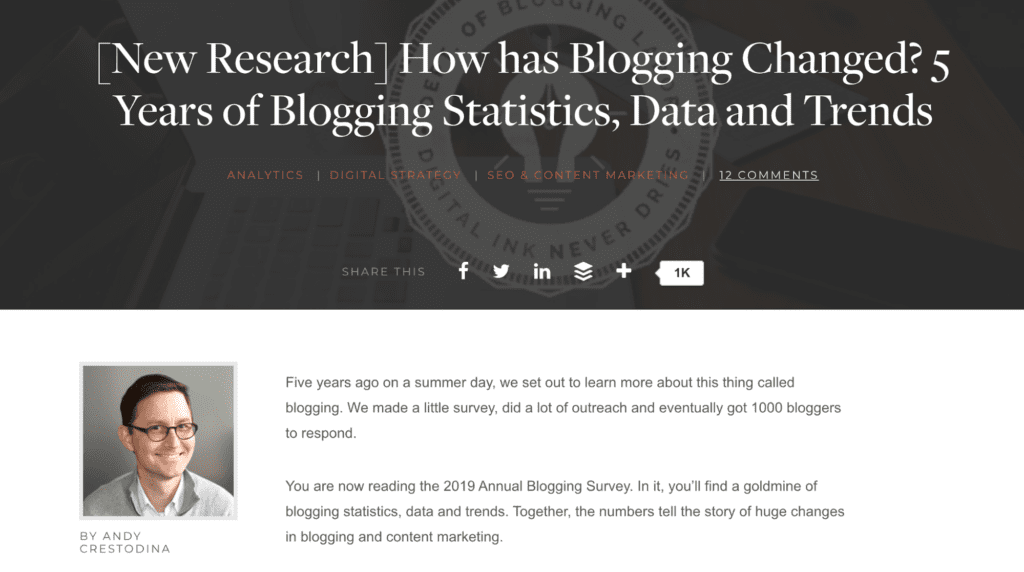
There’s no one-size-fits-all solution here, so to help you make the right decision for your business (and for individual pieces of your content), let’s dive into the pros and cons of both options.
Gated content: pros & cons you need to know
What do you gain by gating your content? What do you miss out on at the same time? That’s what I’ll explain in this section.
Benefits of gated content
Lead generation
No matter what you sell, you need leads. Ecommerce, software, consulting, agencies, and every other type of company you can imagine—they depend on quality leads.
The key word here is ‘quality.’ It means that the content you gate must tackle a pain point of your target customer. It needs to be compelling, helpful, and specific. Its landing page and signup form have to communicate the value of gated content clearly.
Once you win a new lead (or contact), you can put it to great use in many ways, such as:
- Lead nurturing with emails offering relevant free content.
- Customized social media ads.
- Personal outreach to answer questions or offer a similar, high-touch interaction.
Powerful segmentation
If you have more than one piece of gated content, this is a particularly strong benefit. Based on the type of content your prospects have downloaded, you can understand the specific topics they need the most help with.
As a result, you can:
- Send them even more exclusive content based on their topic of interest.
- Create more ungated content on that topic to get on the radar of a similar audience.
- Survey segments of your audience and use their answers in your future content, products, and overall messaging.
For example, Pat Flynn of Smart Passive Income offers a gated ebook about affiliate marketing. In the days after downloading it, he follows up with an automated sequence of emails specific to affiliate marketing and some helpful tools and resources:
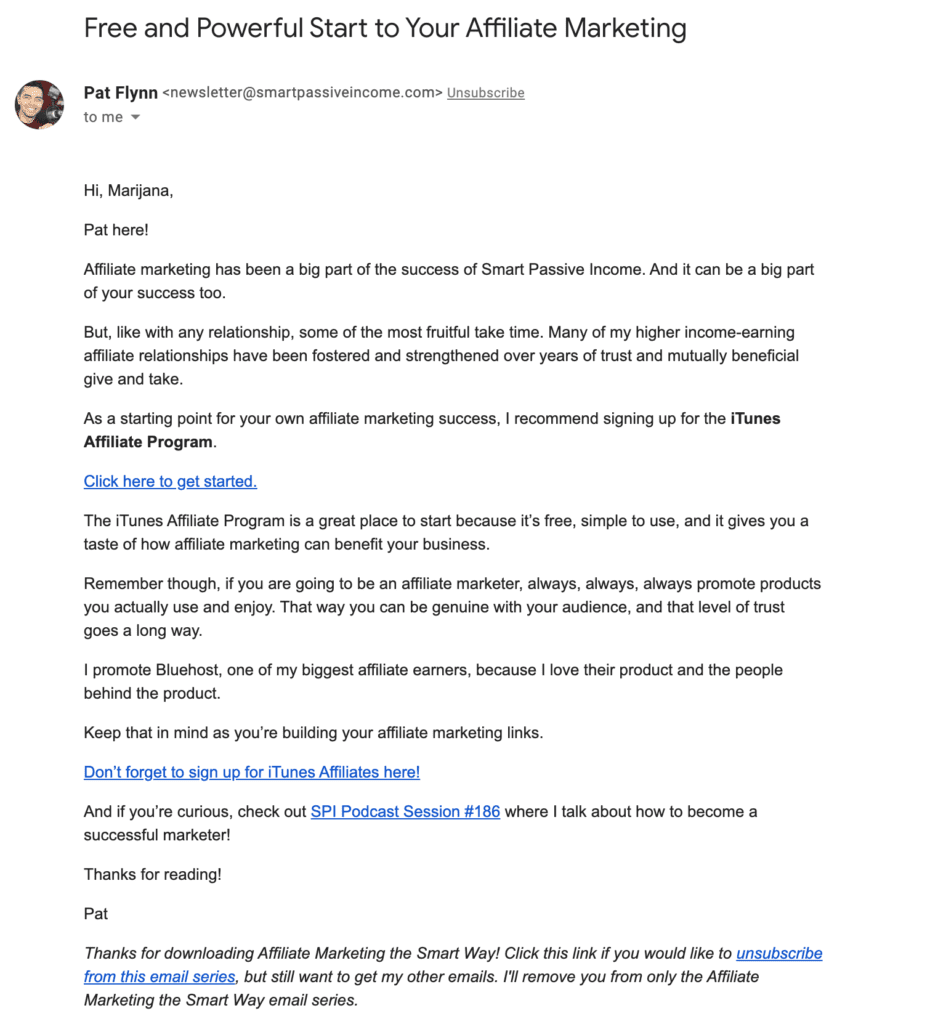
Sense of exclusivity
Gating the right content will give your audience a sense of exclusive access to premium content. This is why it’s essential to only gate content that is truly unique and of deep value.
Why? Because if you gate a piece of content that 25 other companies have published freely, your audience will feel like you’re trying to deceive them.
Drawbacks of gated content
Less SEO benefits
When you hide your content behind a form, there are two crucial limitations:
- Search engines can’t crawl it
- Other companies and publications can’t easily link to your insights
With no links and no ability for Google to crawl and index what’s behind your form, it’s hard to create an organic presence for your gated content.
This is a particularly harmful SEO strategy for startups. Why? Because early in your website’s growth, you want to be gaining traffic and backlinks in order to build your domain authority. However, larger companies can get away with this since they’ve already built up a presence.
Here’s what it comes down to: searchers won’t be able to find your content in search engines if it’s gated. You have to keep actively promoting it via channels like social media and email, otherwise it will never be found.
Limited audience building
The best way to perceive this drawback is this:
Picture a company that decided to make all of their content gated. You have never read a blog post or watched a video from them. The only way to get to their content? Give them your name and email address (and potentially more details, if that’s what their form is asking).
You know nothing about them. You don’t trust them yet. You don’t know if they’ll sell your contact details to a third party. And you have no clue if the content behind the form is even worth it.
That’s the downside of gated content: for it to work, you need a pre-built reputation. This will come in the form of social proof like testimonial and social shares, as well as an organic search presence.
Without that reputation, you’ll struggle to make gated content a successful strategy. It can’t exist in a vacuum.
Ungated content: pros & cons you need to know
Let’s look into the specifics of freely available, ungated content.
Benefits of ungated content
Organic SEO results
A great piece of ungated content can bring you relevant search traffic for months and years to come. That’s the benefit of freely sharing evergreen, educational value through your content.
One of the downsides of gated content we mentioned was the need to consistently promote it in order to bring results.
The SEO potential of ungated content sits on the opposite part of that scale, and it’s worth investing into.
Let’s look at an overview of Nextiva’s organic traffic:
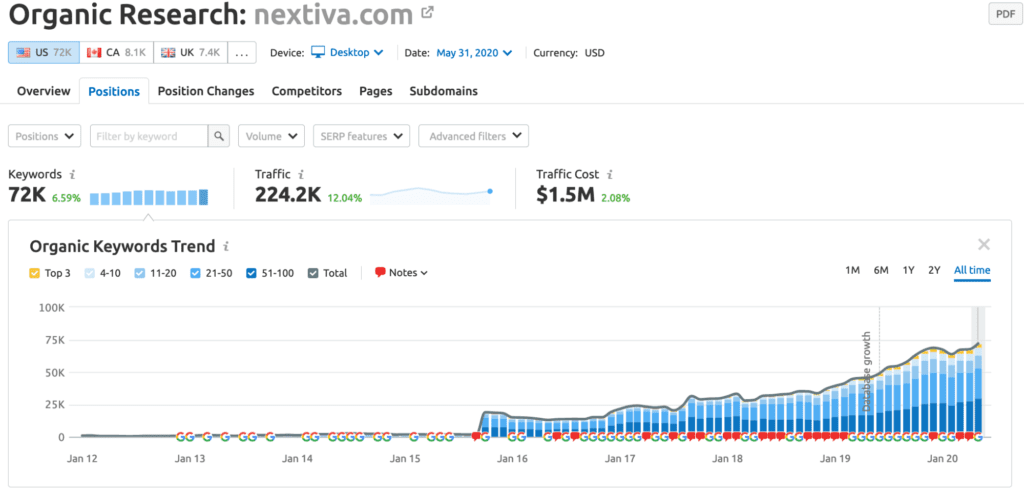
Nextiva’s growth in the last two years has been incredible. Why?
They are ranking organically for high volume search terms like Cloud PBX.

If this was a gated piece of content (and not an ungated informational landing page), it would probably be collecting dust instead of earning valuable organic search traffic.
Reach and engagement
Another benefit of ungated content is its shareability. Original graphs and charts, unique quotes from industry leaders, and easy-to-share takeaways boost this benefit.
In other words, if you focus on ungated content, but make it mediocre or simply a regurgitated version of what’s already out there, you’ll struggle to make an impact.
But when you create ungated content so good that your audience wonders why you didn’t charge for it (including asking for their email as the price), that’s when magic happens. Again, see these results from Orbit’s original research published as a long-form, ungated blog post:

Drawbacks of ungated content
Lost leads
Let’s say a website visitor has landed on your ungated piece of content. They’ve bookmarked it, reread it, and implemented some of your suggested actions. They’ve also shared it with their team and posted about it on social media. They now know about you and trust you as a relevant resource for some of their pain points.
But you have no idea who they are.
You don’t have their name or email address. You don’t know the company they’re from, their industry, or team size.
The only thing you can do is to keep creating and promoting relevant and valuable content and count on them coming back to your website to consume it, which is far from ideal.
Less control over your funnel
This downside is the extension of the previous one. When a visitor becomes your lead, you can use a mix of tools to understand their behavior and map their interests.
For example:
- Links they click on in your emails
- Topics of gated content they’ve downloaded
- Their position in the customer journey based on consuming broader or more specific topics
- Severity of their pain points based on how often they engage with your content
Without a form to collect the initial information, you can’t map your visitor’s behavior to this extent. Even if they end up reaching out through your contact form after reading several posts on your blog, you won’t know this, and you won’t be able to tailor your response to their unique behavior and situation.
How to choose between gated and ungated content
With these pros and cons in mind, how can you be sure about the best approach to content for your company?
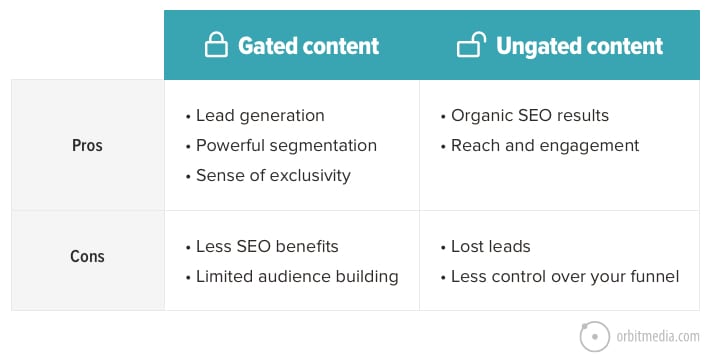
To help you make this decision, here are some questions you should consider.
What resources are available to you?
Be realistic about what you’re working with from a resource perspective. This includes your:
- Team (strategists, writers, editors, designers, etc.)
- Budget
- Technology stack
- Time
Before you start ramping up your content production, it may be worth thinking about splitting up your production board into two tracks: gated vs. ungated, and then start mapping everything out. I’d recommend using a free project management tool to keep things organized and flowing smoothly.
You also have to know your limitations. For example, let’s say you don’t have the budget for running advanced email automations. You should try a free email marketing tool to get things going. At first, your funnel will be basic. That’s perfectly fine. Over time, you can build up to a more advanced one.
What are your short-term and long-term marketing and business goals?
Think about your goals such as:
- New and recurring revenue
- Number of sales you need to hit that revenue
- Number of leads you need to close that many sales (based on your conversion rate)
- Traffic that can support those lead and sales goals
Consider these goals both in the longer term (e.g. the next year), as well as the short term (e.g. the next quarter). Based on this, answer these questions:
- How much traffic and how many leads are you already generating on a regular basis?
- Based on your goals, how much does that need to increase, and in which time frame?
- Which part of the funnel is more important to focus on different periods?
For example, let’s say you need to hit your sales goals immediately because your company is not going to make their quarterly target. Ungated content is obviously not going to help. You need to focus on strategies like referral marketing and outbound prospecting, which are higher velocity activities.
If you have some runway, it probably makes sense to drive more brand awareness and top of the funnel traffic in the short term, but focus on lead generation and bottom of the funnel in latter quarters of the year.
What level of quality and depth is expected in your industry behind a gate?
If gated content seems like your best course of action so far, here’s another factor to consider: what type of content are your competitor’s gating? This question is less about the format itself and more about the depth of information you want to gate.
For example, if your competitors are gating original research, but you’re offering a basic checklist as gated content, you might struggle to convert your visitors into leads.
But if you publish your own original research as ungated content, and put even more valuable insights behind a gate, your visitors will know it’s worth signing up.
What will you do with the information you collect from gated content?
There’s nothing more wasteful than gating high-quality content and doing nothing with the leads you collect.
If that happens and you don’t nurture your leads with an automated email sequence or even just a regular newsletter, you may be better off ungating that content.
Your next steps
Like with most things in online marketing, there’s no universal solution when it comes to gating or ungating your content. Know your goals and start with the resources you already have—this alone will help you understand where you should start.
Then, as you build up your library of content, you’ll be able to test and understand what drives people towards consuming your content. You’ll also see how those that download gated content behaves later in the funnel compared to those that converted through ungated content.
Which of the two options have you used most? What were the results you’ve seen? We’d love to know about your wins and losses!
The post Gating Content vs. Un-Gating Content: Pros & Cons appeared first on Orbit Media Studios.
from Orbit Media Studios https://www.orbitmedia.com/blog/gating-vs-ungating-content/
via IFTTT
from
https://sarahbarnett0.wordpress.com/2020/06/23/gating-content-vs-un-gating-content-pros-cons/
No comments:
Post a Comment